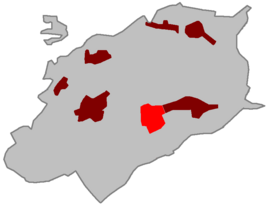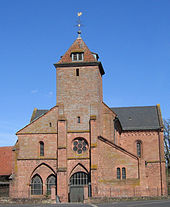Enkenbach
|
Enkenbach
Local community Enkenbach-Alsenborn
|
|
|---|---|
| Coordinates: 49 ° 29 ′ 12 ″ N , 7 ° 54 ′ 12 ″ E | |
| Height : | 290-320 m above sea level NHN |
| Area : | 18.4 km² |
| Residents : | 4377 (Jun. 30, 2007) |
| Population density : | 238 inhabitants / km² |
| Incorporation : | 7th June 1969 |
| Postal code : | 67677 |
| Area code : | 06303 |
|
Location of Enkenbach in the community of Enkenbach-Alsenborn
|
|
Enkenbach is a district of the Palatinate community Enkenbach-Alsenborn in the Kaiserslautern district in Rhineland-Palatinate . Until 1969 it was an independent community.
geography
location
Enkenbach is located on the northwestern edge of the Palatinate Forest and lies on the Klosterbach at 290 to 320 m above sea level. NHN in the eastern part of the district of Kaiserslautern, 11 kilometers from the city of Kaiserslautern , on a slope in a valley that extends from west to east.
The district is wooded in the north-east and south and reaches heights of 360 m above sea level. NHN . The Eselsbach leaves Enkenbach at a height of 254 meters, the Alsenz at 260 meters.
climate
With 750 mm of precipitation per year, Enkenbach is in the middle third of the values recorded in Germany. Lower values are registered at 52% of the measuring stations of the German Weather Service . The driest month is February, the most rainfall occurs in June, i. that is, there is 1.4 times more rainfall than February. Precipitation varies only minimally and is extremely evenly distributed over the year. Lower seasonal fluctuations are recorded at only 1% of the measuring stations .
history
Enkenbach is geographically and historically closely linked to the neighboring village of Alsenborn . During the time of the monastery, the desert areas of Buchholz and Milchborn were located in what is now Enkenbach .
Surname
The name Enkenbach is derived from the Middle High German word enke and means "Viehknechts-" or "Hütejungenbach". It developed as follows:
- 1148 Ynkebach
- 1190 Enkinbach
- 1212 Enkenbach
- 1258 Enkinbach
- 1263 Enkenbach
- 1273 Enkinbach
- 1322 Engkenbach
- 1527 Enkenbach, Enckenbach
- 1837 Enkenbach
middle Ages
In 1635 the village of Baudweiler north of Enkenbach was completely destroyed in the Thirty Years' War .
Premonstratensian Convent
Enke Bach's history is closely linked to the monastery of Premonstratensian together at Enkenbach that in the year 1148 by Count Ludwig von Arnstein and Hunfried of Alsenborn was founded. The nunnery in Enkenbach was settled by nuns from Marienthal (today part of the Rockenhausen Association ) on the Donnersberg who had joined the Premonstratensian order.
The Premonstratensians ( Latin : Candidus et Canonicus Ordo Praemonstratensis ) were founded by Norbert von Xanten in Prémontré in 1120 as a centralized order of regulated canons . They spread rapidly in Germany and were mainly devoted to the Christianization of the Slavs . The Premonstratensian women form the female cooperative founded by Norbert in 1121 with very strict religious rules.
Due to the construction of the monastery church, the Premonstratensian women got into financial difficulties and in 1420 had to pay half of the villages of Enkenbach and Alsenborn to Elector Ludwig III for 100 Rhenish guilders . from the Palatinate . In 1564, Elector Friedrich II had the monastery closed.
The monastery church is now the Catholic parish church of the Enkenbach community.
Modern times
Enkenbach belonged to the Electoral Palatinate until the end of the 18th century and, together with the villages of Alsenborn , Morlautern , Erlenbach , Baalborn and Neukirchen, formed the so-called Büttelamt in the Lautern Oberamt .
From 1798 to 1814, when the Palatinate was part of the French Republic (until 1804) and then part of the Napoleonic Empire , Enkenbach was incorporated into the Canton of Kaiserslautern and was under the Mairie Alsenborn . In 1815 the place had 791 inhabitants. In the same year it was added to Austria . Just one year later, the place, like the entire Palatinate, changed to the Kingdom of Bavaria . From 1818 to 1862 he was a member of the Land Commissioner in Kaiserslautern ; from this the district office of Kaiserslautern emerged. From 1939 Enkenbach was part of the Kaiserslautern district .
After the Second World War , the place became part of the then newly formed state of Rhineland-Palatinate within the French occupation zone . In the course of the first Rhineland-Palatinate administrative reform , the municipality Enkenbach-Alsenborn was newly formed on June 7, 1969 from the previously independent municipalities Enkenbach and Alsenborn . This is one of the local churches Sembach , Mehlingen and Neuhemsbach the enkenbach-alsenborn in the district of Kaiserslautern, which was formed with effect of 22 April 1,972th
coat of arms
|
Blazon : “Split by blue and gold, on the right a golden fountain, from which a fountain column rises with two tubes with flowing silver water and a golden lion turned to the left on the top, on the left a blue-covered red church with silver windows with a blue cross. "
The coat of arms became that of the 1969 newly created local community Enkenbach-Alsenborn |
|
Culture
Buildings
The Daubenbornerhof forms a monument zone; there are also a total of ten individual monuments , including the Catholic Church of St. Norbert and the Obere Eselsmühle .
Events
Every year from Friday before to Tuesday after the second Sunday in July the traditional "Kuckuckskerwe" takes place ( Kerwe is the Palatinate pronunciation variant of Kirchweih ). The highlights are the Kerwe parade followed by a Kerwerede on Sunday and the wheelbarrow race and the Kerwe burial on Tuesday. On February 22nd, St. Peter's Day will be celebrated on site.
Art in public space
- Large sculpture "everyday"
In May 2003, a cast iron ball with a diameter of almost 3 meters and a weight of almost 10 tons was set up in front of the company building of the HegerGuss company .
The model made of polystyrene foam was made by the artist Gottfried Bräuling from Hohenöllen , who gave his large- scale sculpture the title “everyday” . The 9,350 kilogram iron ball with a diameter of 3 meters was cast by the Hegerguss company. Around 90 tons of sand were required to manufacture the spheroidal graphite casting mold .
- Verbandsgemeindebrunnen
In front of the town hall of the community of Enkenbach-Alsenborn there has been a fountain since 1987 , on which the localities of that time are depicted with their Uznames.
- Stone relief on the council chamber
The sandstone relief on the council chamber of the Verbandsgemeinde shows the coats of arms of the five municipalities in the middle.
- Relief in the council chamber
The theme of the relief in the council chamber is based on the Bible passage from the prophet Isaiah , 1. 2, 4:
And he will judge the heathen and correct many peoples. Then they will make their swords into plowshares and their spears into sickles. For no people will lift up the sword against the other and they will no longer learn to wage war.
The artist, Wolfgang Seipenbusch, has put together many individual pieces of wood and wants to express that there is only a basis for a community through cohesion.
Two graves can be seen in the lower left. The cross with the steel helmet serves as a reminder to the dead of war. The other cross is a reminder that our time is limited.
A man's fist is shown below using a sword as a ploughshare. This plow is pulled by a winged horse that pulls up towards a high goal. A child on horseback leads him on the right path. With the other hand, it points to the hourglass on the horse's head.
Below is a shield of a mercenary made of wood and buffalo leather. He threw it away because it is no longer needed. In addition, a family worried about their daily bread, who convulsively hold their empty bowl. Above this, a figure can be seen as a mentally rational aspect who reads a book on his knees. Two devoted musicians can be seen above. The soul is carried up by the bird.
Economy and Infrastructure
traffic
The Enkenbach station was opened in 1870 with the Alsenz Valley Railway section from Hochspeyer to Winweiler, which was linked to Bad Münster in the following year. In the following period it developed into an important railway junction. In 1875 the Kaiserslautern – Enkenbach railway was added. In 1932 the Eistalbahn Grünstadt – Eisenberg , which opened in 1876, was tied through to Enkenbach. Passenger traffic was discontinued on the latter in 1976, and freight traffic followed in 1988. Although the passenger traffic between Grünstadt and Eiswoog was gradually reactivated in the period from 1994 to 2001, plans to implement this for the remaining section also failed.
Institutions
Enkenbach is the seat of a police school. The local gymnastics and police sports club Enkenbach and SV Enkenbach exist as clubs .
Personalities
Honorary citizen
- 1933: Daniel Häberle (1864–1934), geologist, paleontologist and local history researcher from the Palatinate
Born in Enkenbach
- Johannes Häberle (1790–1858), participant in the Hambach Festival
- Daniel Häberle (1864–1934), geologist, paleontologist and local history researcher from the Palatinate
- Wilhelm Mayer (1874–1923), politician (ZENTRUM, BVP), member of the Reichstag, Reich Treasury Minister
- Martin Migeot (1897–1967), farmer and politician (FDP)
- Christine Kuby (* 1957), terrorist (RAF)
Connected with Enkenbach
- Johann Michael Hartung (1708–1763), builder of the organ in the church of Enkenbach
- Cornelius F. Klassen (1894–1954), member of the Mennonite Brethren Congregation in Canada, organizer of building programs for the local Mennonites
- Carl Schneider (1900–1977), theologian, head of the Evangelical Academy in Enkenbach
- Emil Gauer (1905–1991), politician (NSDAP), died on site
- Rudi Müller (1927–2003) made himself known in the world for his support of the American conscientious objectors (Pax-Boys) who were active in building settlements for Mennonite war displaced persons in the community of Enkenbach
- Arnold Bittlinger (* 1928), led a large conference on site in 1963
- Elisabeth von Dyck (1950–1979), terrorist (RAF), grew up in Enkenbach and was buried
- Sascha Hildmann (* 1972), soccer player, played for SV Enkenbach in his youth
Individual evidence
- ↑ Official municipality directory (= State Statistical Office of Rhineland-Palatinate [Hrsg.]: Statistical volumes . Volume 407 ). Bad Ems February 2016, p. 163 (PDF; 2.8 MB).










